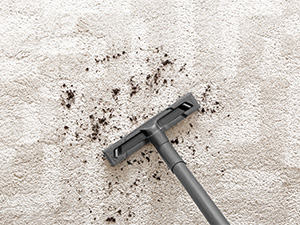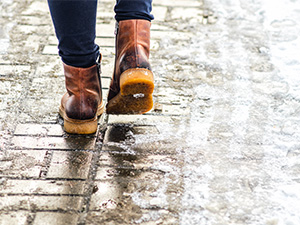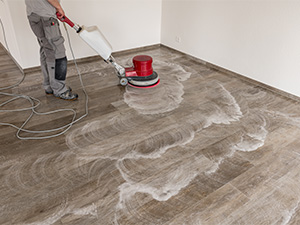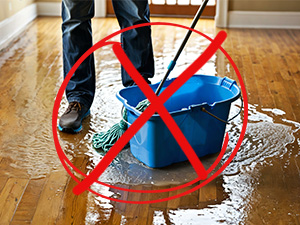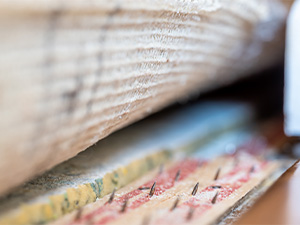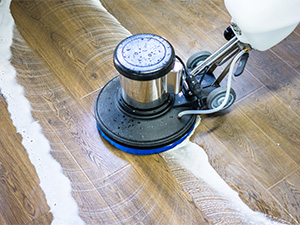CLEANING TIPS FOR HARDWOOD FLOORS
First, let’s talk about an important DON’T—Over Wetting.
Water and wet mopping should be limited, and an overabundance of water or cleaners is not necessary nor recommended. In general, wood surfaces are not “wet-loving” to begin with. Limit how much and how often you use water to clean your wood surfaces!
Most people get that concept when it comes to other wood surfaces like furniture and cabinetry, but they don’t when it comes to caring for wood floors. And depending on the type of finish on the hardwood floors water can be a real problem. To explain further, there are two types of finishes wood floors have. They are:
- Top Finishes A top finish on hardwood is best explained as a coating that is engineered and designed to lay on top of the floor which creates a waterproof barrier on the surface of the wood. Commonly it is known as “polyurethane.” Polyurethane is like plastic and waterproofs the surface keeping things from absorbing into the wood.
- Penetrating Finishes Conversely, a penetrating finish is a finish that absorbs into the wood cell structure instead of a finish that lays on top. Perhaps a more traditional finish, these products may be oils, paste waxes, and the like. Again, the finish absorbs into the finish.
Polyurethane Finishes Withstand, or “Mostly Tolerate,” Some Wet Cleaning
Because polyurethane finishes sit on top of the wood rather than seeping into it, they handle moisture better than penetrating finishes. However, too much water can still damage the floor by compromising the finish and the wood underneath. As a result, it’s best to avoid excessive wetting—even on polyurethane-coated floors—and to limit water use overall when cleaning.
Penetrating Finishes Are NOT as Tolerant of Wet Cleaning
An overabundance of water on a penetrating finished floor is NOT encouraged, it is not tolerant of excessive water at all! Instead, the water may absorb into the cell structure and damage it. Likewise, if too much water is used it will begin to react with the penetrating finish and cause it to act up too. In example, you may see the appearance of the floor turn milky or whiteish. To sum it up, wood floors in general should not be “over-wet-cleaned!” Therefore, eliminate using (or limit) a bucket with a rag or wet mop to do so!
DO Ditch Wet Mopping and Begin to Think Dust Mopping
Wood floors are more simply treated with a good dry dust mop or vacuuming. If you are dust mopping you can use, but perhaps should not use, a pre-treated dust mop. Or, if you have a mop with a treatment canister you should consider using it sparingly. Although formulated and advertised as suited for cleaning floors, again additives are put into these solutions that will create residues that can contaminate the floors down the road.
Dusting a Floor
Keep your floor cleaning efforts simple yet effective. Dusting per se can be accomplished with a dry dust mop or a suitable vacuum attachment that is designed for dust collection and removal.
Dry dust mop A microfiber Velcro strip “mop” is ideal. Sold as such it comes with a stick handle and a rectangular frame where the rectangular mop strip attaches. Use it completely dry, untreated is perfectly fine. Once dirty switch it our for a clean one, and proceed again.
Dry dust vacuuming Let the convenience of mechanized dust collection and removal work on your behalf! In plain speak, a vacuum with attachments that don’t damage the wood surface are ideal. To be specific, ideally it is good to use a vacuum wand with a felt attached to the wand “shoe.” (TIP: Make sure the plastic or rubber wheels on the vacuum are kept free of grit and dirt to avoid scratching the floor.) Or you can use one with a soft bristle brush on it. And a third alternative is an upright or automatic vacuum that has a high setting for vacuuming the floor either with or without a brush or felt attachment.
All in all, hardwood floors are preferably cleaned with effective dry dusting!
But Then, There’s Cleaning Up a Spill
By now it might be conveyed that you shouldn’t or don’t need to wet mop your floor regularly. Cleaning up spills and such are better handled with a wet rag preferably at the time the spill occurs. And to manage that, a hand rag may be most suitable. If a large spill or leak occurs, a mop and bucket, or even a wet vac, is the better choice. But again, don’t let puddles of liquids dwell on the floor for too long.
Other Wood Floor Care Do’s and Don’ts
DON’T Use a Steam Mop to Wet Clean or Steam Clean Your Wood Floors!
While it won’t be elaborated here, it is recommended that wood floors not be steam cleaned with a steam mop! Even though the steam mop manufacturer and advertising on TV says it’s ok, it is not! Steaming of either type of finished hardwood floor is not encouraged because damage to both kinds of finishes, and ultimately the wood itself will occur.
DON’T Over-use Shine Restoring Products!
Shine restoring products are a whole different conversation, which should be discussed and dealt with separately. Overuse of shine restoring products will upset the balance of the finish or floor, and cause problems down the road. It is just better to steer clear of using them. Or, if you must, understand that shine restoring products merely are a band aid solution to bigger problem.
DO Use a Good Neutral Cleaner.
When cleaning hardwood floors, a good neutral floor cleaner is best! Neutral cleaner is a category of cleaner whose pH composition is a pH of 7. Because wood and flooring are both best cleaned with a pH of 7, that is all that is recommended. (In box stores and hardware stores look for “neutral floor cleaner.”)
DON’T Use Cleaners That Have Heavy Ingredient Additives. They Are Unnecessary and Will Contaminate the Floor if Used.
This might include heavy oils, fragrances and disinfectants.
Avoid:
- Cleaners with labels that denote “oil” as part of their name or on their ingredient list.
- Low-end cleaners, maid-service favorites that are not so “lo so” recommended.
- Anything that indicates a fragrance (which is used for your olfactory stimulation only). Fragrance does nothing for the wood surface whatsoever.
- Heavy disinfectants. They are unnecessary.
- Pre-treated dust strips (micro-fiber or regular ones). They tend to leave a slippery residue on the wood floor that can become a slip and fall hazard. Avoid them altogether, or sparsely use them with caution only.
Instead, a light duty neutral floor cleaner will be sufficient and not complicate nor contaminate the floor with residues.
“Daily Neutral Cleaning” Products and Kits are Recommended and Better Suited for Daily or Regular On-going and Periodic Cleaning!
First off, don’t get caught up in the literal translation of “daily cleaning.” This does not refer to, nor mean, you need to do this type of cleaning daily. It does, however, refer to a safer group of products suitable for basic cleaning tasks, whatever your frequency preference is (daily, weekly, bi-weekly, etc.).
Daily Cleaners Can Be Purchased in a Couple of Convenient Ways, and, Hint, Look for the Word “Daily”
- A spray bottle of daily cleaner available on the shelves or online.
- A gallon of the same cleaner similarly available suitable for refilling the spray bottle.
- A” kit” as a one-time purchase (comes in a box) that includes a “stick mop” (2 pc stick handle, a frame, and one or more Velcro strip mops), and a spray bottle of daily cleaner.
How Best to Use Your Daily Cleaner
Many times, the practice is to spray the floor with the cleaner used. Doing this uses way too much cleaner. Besides using up your bottle of cleaning solution way too fast, you also more quickly contaminate the floor by depositing more chemistry and solution than is needed to clean it.
Instead, withhold that temptation! Spray the strip mop or rag with the spray cleaner. That is all that is necessary! This is a way easier method that keeps it simple to clean your floors. But caution, even some “daily cleaners” will leave residues!
Although more technical diagnosis, even some daily cleaning products will promote a residue build up over time. For this reason, it might be encouraged to periodically use a dry mop (untreated) to buff off any subtle build up of haziness and residue that becomes noticeable on the floor. Akin to using the rinse cycle in your washing of your clothes, whereby the rinse cycle flushes out the detergents, dirt, soils and oils from your clothes. A dry dust mop that soft buffs (nothing abrasive AT ALL!) the floor will remove the film buildup on the floor. After that, good to go as in “spray buff” the mop strip, rinse and repeat!”
In Summation About Cleaning Your Hardwood Floors
Perhaps now the hint is communicated that “less is better!” Less water (if any), and certainly less cleaning product with heavy ingredients should be avoided. Get the “some is good- more is better” thought out of your head (otherwise also known as the “glug-glug” method). Replace the temptation with a reserved practice of limited amount of water and a limited amount of “product”. Remember, water is not a friend to wood! And dry treatments, despite your reluctance, will ensure longer lasting, cleaner and less contaminated or damaged floors.
By Wendy Fenske. This article is one of a series of Caring For It™ articles written and published on behalf of Surface Care PRO Partners.

